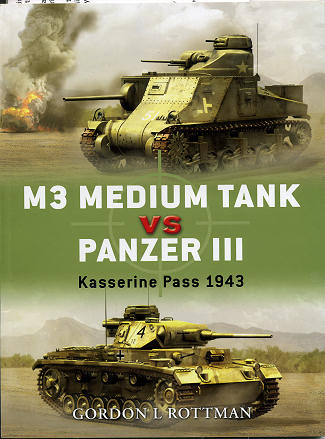 This is
#10 in the very popular 'Duel' series and this time, it takes a look at the
German Panzer III and the US M3 Lee tanks during the Kasserine Pass battles of
1943. This was the last German victory in the desert before they were driven out
of North Africa just a few months later.
This is
#10 in the very popular 'Duel' series and this time, it takes a look at the
German Panzer III and the US M3 Lee tanks during the Kasserine Pass battles of
1943. This was the last German victory in the desert before they were driven out
of North Africa just a few months later.
It was also a major learning experience
for the American Army, which seemed to do just about everything wrong during
this conflict. However, one has to learn and part of the training of the units
involved did not include open country, desert warfare. It was also a battle that
showed American generals that one could not rely on set strategy and that the
moment plans got underway, there was always something that would upset them and
make them obsolete.
One thing learned was that the M3 Lee was
not the tank that was needed in modern warfare against the Germans. Though it
had a superb 75mm main gun, the limited traverse of the weapon put those who
used it at a distinct disadvantage. Though not as heavily armed, the Panzer III
(which in reality was more of a light tank than a medium one) had the benefit of
considerable updating and generally had very experienced crews. Though heavily
outnumbered in both troops and equipment, the German tank corps was able to
route the inexperienced US Army and do considerable damage in terms of destroyed
US equipment.
In line with other books in this series,
the author takes a look at the design and development of both of the tanks, then
looks at the strategic situation in which these weapons found themselves in
early 1943. There is a section on the technical specifications of the two tanks,
followed by a piece on the training of the combatants as well as what it was
like to be a member of a tank crew. One doesn't think about such things, but it
was pointed out that there are no, well, relief facilities in a tank. Members
had to use what was available when the tank was buttoned up (sometimes for days)
and spillage could be a problem. I found it funny that the US crews generally
used empty metal ammo cans, dumping them out when full, much to the disgust of
the infantryman who found one, thinking it would be a useful thing to have!
The book then goes on to detail this
initial major combat between the two forces, following up with an analysis of
the event and what came afterwards.
All of this is superbly illustrated with
maps, cutaways, and period photographs, making this edition a must-have for
those interested in the combat capabilities of these two machines.
May 2008
For more on the complete line of Osprey books,
visit www.ospreypublishing.com. In the US, it is
Osprey Direct at 44-02 23rd St, Suite 219, Long Island City, NY 11101., where you can
get a catalogue of available books.
If you would like your product reviewed fairly and quickly by a
site that has nearly 400,000 visitors a month, please contact
me or see other details in the Note to
Contributors.
 This is
#10 in the very popular 'Duel' series and this time, it takes a look at the
German Panzer III and the US M3 Lee tanks during the Kasserine Pass battles of
1943. This was the last German victory in the desert before they were driven out
of North Africa just a few months later.
This is
#10 in the very popular 'Duel' series and this time, it takes a look at the
German Panzer III and the US M3 Lee tanks during the Kasserine Pass battles of
1943. This was the last German victory in the desert before they were driven out
of North Africa just a few months later.